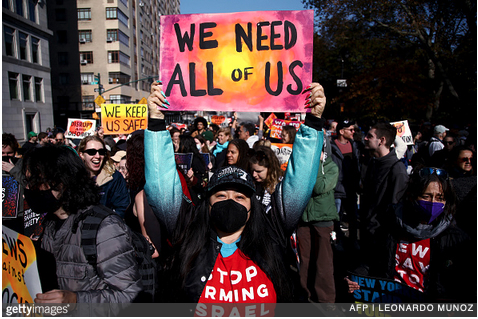(Originally Published in the New York Times by Louise Erdrich, December 28th 2020)
Not Just Another Pipeline
The expansion of Enbridge’s Line 3 pipeline is a breathtaking
betrayal of Minnesota’s Indigenous communities — and the
environment.
By Louise Erdrich
Ms. Erdrich, a member of the Turtle Mountain Band of Chippewa, is a novelist and
poet based in Minnesota. Her most recent book is “The Night Watchman.”
Dec. 28, 2020, 5:00 a.m. ET
47
A young Line 3 protester in Palisade, Minn., near a construction site this month. Alex
Kormann/Star Tribune, via Associated Press
PALISADE, Minn. — My daughter and I are walking along the
fast-flowing stream of pure darkness that is the young Mississippi
River. We are two hours north of Minneapolis, in Palisade, Minn.,
where people are gathering to oppose the Line 3 pipeline. Patches
of snow crunch on pads of russet leaves as we near the
zhaabondawaan, a sacred lodge along the river’s banks. It is here
that Enbridge is due to horizontally drill a new pipeline crossing
beneath the river. We enter the lodge. The peace, the sweetness,
the clarity of the water is hard to bear. The brush and trees hardly
muffle the roar of earth-moving and tree-felling equipment across
the road. The pipeline is almost at the river.
Last month, Minnesota Gov. Tim Walz’s administration signed off
on final water permits for Enbridge to complete an expansion of its
Line 3 pipeline. After the final section is built in Minnesota, the
pipeline will pump oil sands and other forms of crude oil from
Hardisty, Alberta, to Superior, Wis., cutting through Indigenous
treaty lands along the way. Lawsuits — including one by the White
Earth and Red Lake nations and several environmental
organizations, and another by the Mille Lacs Nation — are
pending. But construction has already started.
This has been a brutal year for Indigenous people, who have
suffered nearly double the Covid-19 mortality rate of white
Americans. We have lost many of our elders, our language keepers.
Covid has also struck an inordinate number of our vibrant young.
Nevertheless, tribal people worked hard on the elections. The
Native vote became a force that helped carry several key areas of
the country and our state. On the heels of those victories, the
granting of final permits to construct Enbridge’s Line 3, which will
cross Anishinaabe treaty lands, was a breathtaking betrayal. The
Land of 10,000 Lakes is already suffering from climate change. Yet
Minnesota’s pollution control and public utility agencies refused to
take the future of our lakes into account, or to consider treaty
rights, in granting permits.
This is not just another pipeline. It is a tar sands climate bomb; if
completed, it will facilitate the production of crude oil for decades
to come. Tar sands are among the most carbon-intensive fuels on
the planet. The state’s environmental impact assessment of the
project found the pipeline’s carbon output could be 193 million tons
per year. That’s the equivalent of 50 coal-fired power plants or 38
million vehicles on our roads, according to Jim Doyle, a physicist at
Macalester College who helped write a report from the climate
action organization MN350 about the pipeline. He observed that
the pipeline’s greenhouse gas emissions are greater than the
yearly output of the entire state. If the pipeline is built,
Minnesotans could turn off everything in the state, stop traveling
and still not come close to meeting the state’s emission reduction
goals. The impact assessment also states that the potential social
cost of this pipeline is $287 billion over 30 years.
Carbon footprint aside, the extraction process for oil sands is
deeply destructive. Mining the sands often requires scraping off
the life-giving boreal forest growing over Alberta’s oil fields.
Photographs of Alberta’s oil sands sites show a vast moonscape
impossible to reclaim. The water used in processing is left in toxic
holding ponds that cumulatively could fill 500,000 Olympic
swimming pools, as one National Geographic article puts it.
And if the pipelines were to leak, the sludgy mixture is almost
impossible to clean up. The state’s environmental impact statement
notes that the pipeline will run through two watersheds that drain
into Lake Superior. Any spill in the vicinity of the Great Lakes,
which contain 84 percent of North America’s available freshwater,
is an existential threat to our water supply. The climate action
group 350Kishwaukee compiled data from Enbridge websites and
found at least 1,000 spills by Enbridge pipelines between 1996 and
2014, including a disastrous spill into the Kalamazoo River, which
flows into Lake Michigan. The Environmental Protection Agency
estimated in 2013 that in spite of an extensive effort, just over
160,000 gallons of oil would remain in the river.
CLIMATE FWD:: Our latest insights about climate change, with
answers to your questions and tips on how to help.Sign Up
“There is nowhere worse on earth to have an oil sands pipeline
system than the Great Lakes region,” says Rachel Havrelock, the
founder of the University of Illinois Freshwater Lab. “It is,
everything else aside, the world’s worst planning.”
The thing is, there was no plan. There is no plan. It’s clear to me
that with the Keystone XL Pipeline on hold and Line 5 challenged
in Michigan, Enbridge is building as fast as it can to lock in pipeline
infrastructure before regulatory agencies and governments
institute rules on climate change. Global financial institutions have
been realizing the environmental cost of the fossil fuel industry.
Last year, Moody’s downgraded Alberta’s creditworthiness to its
lowest level in 20 years, citing (among other issues) the province’s
reliance on oil sands. Black Rock, HSBC, Deutsche Bank and many
other global financial institutions have taken steps to divest from
fossil fuels.
But instead of pulling back their production levels, many oil sands
companies, with the support of Canadian banks, doubled down,
producing a surplus. These Canada-based corporations are
perpetrating a vast ecological crime, and Minnesota is their
accomplice. But we could cross over to something better. Tar sands
do not have to flow through this pipeline. The rivers can heal, the
great scars gouged into the wetlands regenerate.
ADVERTISEMENT
Many tribal traditions recognize women as keepers of water. It is a
spiritual as well as practical responsibility, and therefore especially
meaningful that Deb Haaland, a member of the Laguna Pueblo, has
been chosen as our next interior secretary. Peggy Flanagan,
Minnesota’s lieutenant governor and a White Earth tribal member,
has taken a firm stand against Line 3. Organizations led by
Anishinaabe women have taken every available legal path to
protect our waters, but are now engaged in an on-the-ground battle
for the future, which brings us back to the lodge by the river. We
are here on earth, omaa akiing, and the waters are alive with
energy.
One protester named Liam, who grew up in northern Minnesota
and near Lake Superior in Wisconsin, spent 12 days camped in a
tree directly in the path of Enbridge equipment and was finally
arrested by an officer in a cherry picker. Liam tells me, “This is my
home. I love the river like a friend and the lake like my mother.”
Young people here are chaining themselves beneath pipeline
trucks, clamping themselves to bulldozers, facing down semi
trucks. It is unbearable. They know exactly what’s at stake.
The Mississippi widens and becomes mighty as it flows south.
Holding my daughter’s graceful hand in my own, listening to her
sing an ancient song to the four directions, I can feel her strength
and her fragility. In the protest camp, people are talking around the
fires about First Nations resistance and Standing Rock — they held
off a pipeline; so can we. Every morning at 10, people gather to
pray. Every day there are more people in the circle.
Louise Erdrich, a member of the Turtle Mountain Band of Chippewa, is the author, most
recently, of the novel “The Night Watchman.”
The Times is committed to publishing a diversity of letters to the editor. We’d like to hear
what you think about this or any of our articles. Here are some tips. And here’s our email:
letters@nytimes.com.


